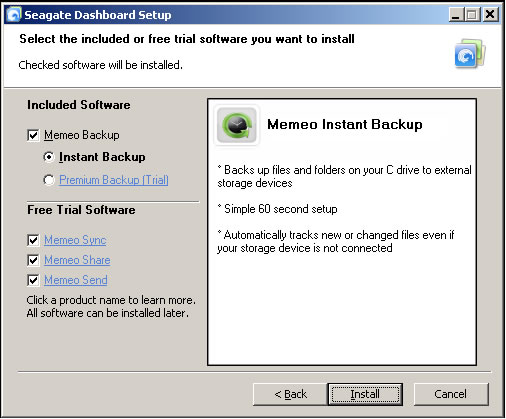

- #SEAGATE DASHBOARD INSTALLER EXE SERIAL NUMBER#
- #SEAGATE DASHBOARD INSTALLER EXE INSTALL#
- #SEAGATE DASHBOARD INSTALLER EXE SERIAL#
- #SEAGATE DASHBOARD INSTALLER EXE FULL#
#SEAGATE DASHBOARD INSTALLER EXE SERIAL#
With a tad more research I found that if you enter a string after the php like this where xxxx = your serial number, it should work.
#SEAGATE DASHBOARD INSTALLER EXE SERIAL NUMBER#
īut of course the area for entering the serial number of your drive is grayed out and can't be entered - hence, you can't register your device. Researching the support forums, I eventually made my way to the online registration form.

Then again, it won't work with the "cloud" option of the Seagate backup software, so I moved on. the limitations say it only allows 3 backups - I assume that means 3 current backups, not 3 uses - if so that could be handy. Surfing The Net, I did find that Seagate has a free 100 Gig plan though eVault. It took a few hours for a registration email arrive and there was nothing about cloud storage, accounts or passwords mentioned and the program did not recognize my email address that I used for registration. At least none that I could find but then Dashboard software said instructions would be in my registration mail. Clicking the cloud button - It indicated that by registering, I'd have some sort of cloud option. Then I saw the little "cloud" shaped button.
#SEAGATE DASHBOARD INSTALLER EXE FULL#
I also created a second backup job for daily at night for the full system.Īll that worked very well. In my case I chose Snapshot for photos, which took a back up right now of all my photos, then updates any data changes to photos on the fly. For office machines it would be fine, but gaming or high use- not so much. The default back up schedule is "continuously" which is the safest thing to do. You have a number of choices for a backup schedule, daily, monthly, weekly, monthly, hourly, snapshot and continuously. It's simple enough that anyone can use, yet it also has advanced options to be more selective for those of us who are a tad more finicky about what they need to store. The interface walks you through the rest. Just click Home>Protect>New Backup Up Plan to start a new backup job. The dashboard Backup program itself is very nice.
#SEAGATE DASHBOARD INSTALLER EXE INSTALL#
On the new drive, you will find the file 'Seagate Dashboard Installer.exe' run that and it will walk you through the process of registering your hardware with Seagate for warranty and also install the Seagate Dashboard backup program. I'm OK with both those as this device is for office backup and not intended to be portable. Also, it is not USB powered so you need the extra power cable.


The drive is one the bigger side, about 2.5 times the size of my Free Agent drive. (130+ MB/s read) Now that said, if you do not have USB 3.0 - expect something more like 30-35 MB/s read -write, still that's fine for backups. That's not too shabby), and read /writes were well within or better than what I would expect from a current external drive. Jacked into my USB 3.0 hub, I was able to consistently grab approximately 10 Gig in about 3 minute, ( 3.3 gig per minute. I'll argue with you as to why and which way is better, but that's for the forums. No, they didn't rip you off of 0.37 TB, it's that Windows does the math based on 1024 bytes as opposed to 1000 bytes. When you look at the device in Windows, you'll notice that the drive will show as 3.63 TB and not 4 TB. Plug in the power cable and plug in the provided USB 3.0 cable and your machine will detect it like any other drive. 4 TB, 2 year warranty, USB 3.0 and about $40 more than a comparable 3 TB- what's not to like? So I grabbed it, brought it home, ripped open the box and proceeded to save my digital I liked it enough that I thought it deserved digging into a bit deeper. Luckily my local electronics shop had a 4TB Seagate Backup Plus for about $170 on hand. Being that I take a LOT of pictures, I needed something large. Ok, I was having an urgent issue with my faithful Windows Home Media Server becoming cranky.


 0 kommentar(er)
0 kommentar(er)
